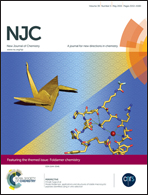Fe3O4@porous carbon hybrid as the anode material for a lithium-ion battery: performance optimization by composition and microstructure tailoring†
Abstract
Confining Fe3O4 into nanoporous carbon frameworks has been achieved through self-assembly and the use of a subsequent syn-carbonization strategy, where Fe3O4 and carbon frameworks are generated simultaneously and Fe3O4 particles are confined into porous carbon frameworks (Fe3O4@C). Both the composition and microstructure have a significant effect on the electrochemical performances. In comparison with bulk Fe3O4, Fe3O4@C-2 with optimal void pore volume and oxide content shows a significant enhancement in both cycling stability and high-rate capacity. The reversible capacity of Fe3O4@C-2 is retained at 932 mA h g−1 after 100 cycles compared to only 410 mA h g−1 for bulk Fe3O4. The capacity of Fe3O4@C-2 at the current density of 2 A g−1 has been significantly improved to 478 mA h g−1 from only 26 mA h g−1 for bulk Fe3O4. The considerable enhancement of both the cyclability and high-rate capability can be attributed to the synergic effect of nanoconfinement as well as the optimized composition and microstructure: the good dispersion of oxide particles, and the efficient volume change alleviation during the discharge–charge process.


 Please wait while we load your content...
Please wait while we load your content...